Questions about pain, scarring, recovery time, and emotional adjustment are often at the front of every patient’s mind. Breast reconstruction recovery is not only about physical healing, it is also about regaining confidence, adapting to body changes, and learning what is normal during each stage of the process. Some women worry about how soon they can return to daily routines, while others are anxious about potential complications or whether they will feel “like themselves” again.
This guide is designed to ease those concerns. By explaining the recovery timeline, offering practical tips for comfort and care, and addressing the emotional side of healing, it provides patients with a clear roadmap to a smoother breast reconstruction recovery.
Table of Contents
ToggleUnderstanding Breast Reconstruction Recovery
Every patient’s breast reconstruction recovery journey is unique, but knowing what to expect can help reduce anxiety and set realistic goals for healing. Recovery is not only about waiting for incisions to close; it involves regaining strength, protecting surgical results, and adapting to physical and emotional changes.
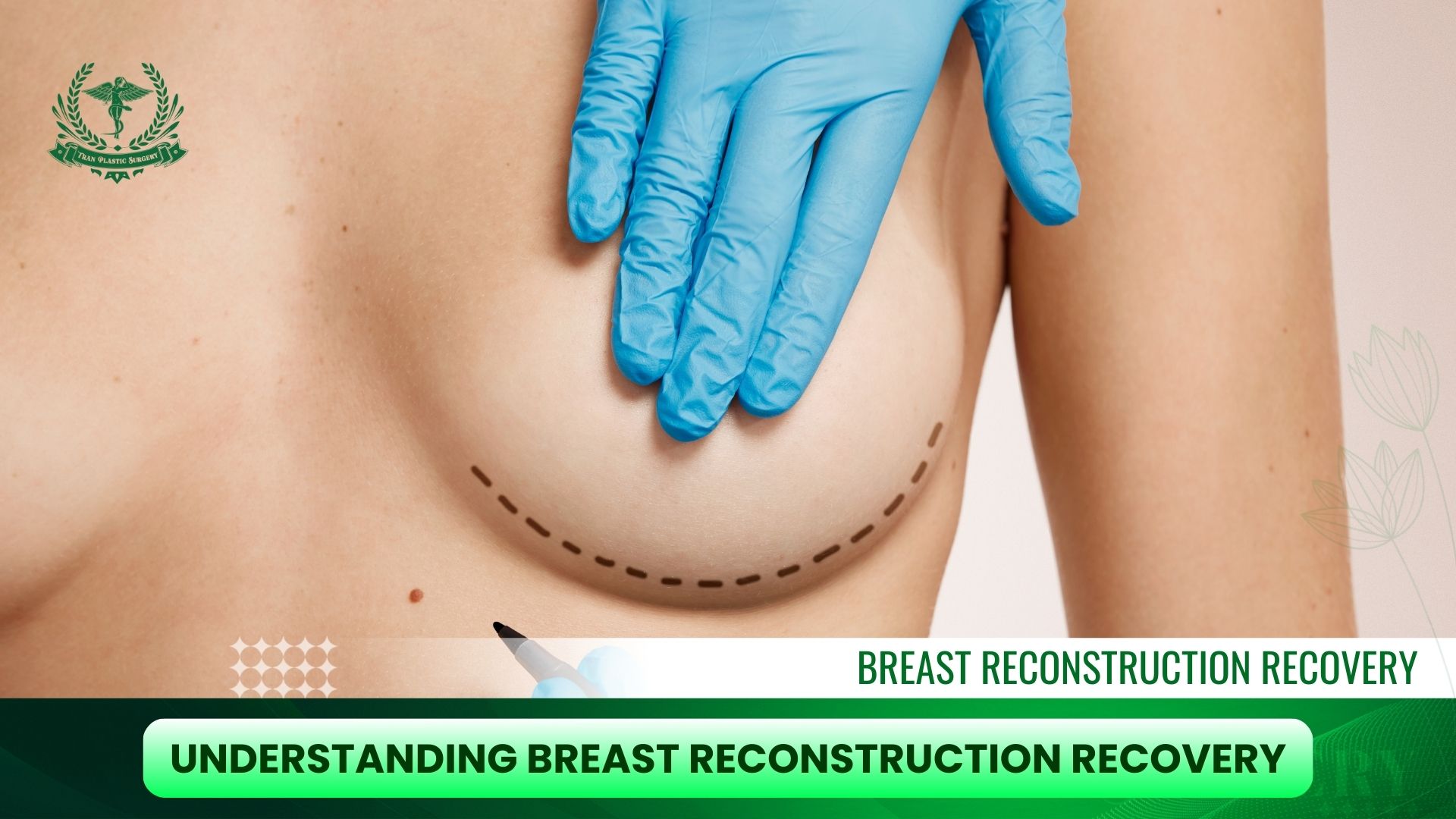
1. Key Factors That Influence Recovery
- Type of reconstruction surgery – Recovery varies depending on whether you had implant-based reconstruction or a flap (autologous tissue) procedure. Implant recovery is often shorter, while flap surgery usually requires more healing time because it involves tissue transfer.
- Overall health and lifestyle – Patients who maintain a balanced diet, avoid smoking, and manage chronic conditions generally heal faster.
- Post-surgical care – Following your surgeon’s instructions on wound care, drain management, and activity restrictions is critical to ensuring a smooth breast reconstruction recovery.
- Support system – Having family, friends, or caregivers available to assist during the first weeks can significantly improve comfort and emotional well-being.
2. Physical and Emotional Aspects of Recovery
- Physical healing includes managing swelling, bruising, and temporary loss of sensation in the chest area. These side effects are expected and gradually improve over time.
- Emotional recovery is equally important. Some women may feel relief and renewed confidence, while others experience sadness or frustration with body image changes. Both responses are normal and part of the overall breast reconstruction recovery process.
Patients can approach recovery with confidence and realistic expectations by understanding these factors and acknowledging both the physical and emotional sides of healing.
Read more: Breast Augmentation Recovery Timeline & Healing Guide
Breast Reconstruction Recovery Timeline
One of the biggest concerns patients have is, “How long will my breast reconstruction recovery take?” While every journey is different, most women follow a similar healing pattern. Understanding the general timeline helps set expectations and reduces unnecessary worry.
1. Week 1–2: Immediate Recovery
- Expect soreness, swelling, and bruising around the surgical area.
- Surgical drains may be in place to prevent fluid buildup.
- Pain is usually managed with prescribed medications and supportive garments such as a surgical bra or compression wrap.
- Rest is essential, and most patients need help with daily activities.
2. Week 2–6: Early Healing Stage
- Stitches and drains are usually removed within the first few weeks.
- Light movement and gentle walking are encouraged to promote circulation and reduce the risk of blood clots.
- Patients may still feel fatigued but will gradually regain strength.
- Most women can return to light daily activities or part-time work (non-physical jobs) by week 4.
3. From 6–8 Weeks: Regaining Normal Activities
- Pain and swelling begin to ease significantly.
- Many patients can return to regular routines, including work and light exercise, but should still avoid heavy lifting or strenuous activity.
- Scars begin to mature and may appear pink or firm; they will soften and fade over time.
4. From 3–6 Months: Continued Healing
- Sensation changes (such as numbness or tingling) may persist but usually improve gradually.
- Energy levels continue to stabilize.
- Patients can usually resume most physical activities, including exercise, with their surgeon’s approval.
5. From 6–12 Months: Long-Term Recovery
- Scars flatten and fade, though they may never disappear completely.
- Reconstructed breasts settle into their final shape and position.
- Emotional recovery often deepens as patients feel more confident and adjusted to their new body.
While the typical breast reconstruction recovery timeline can last 6–8 weeks for basic healing, full recovery including emotional adjustment and scar maturation can take up to a year.
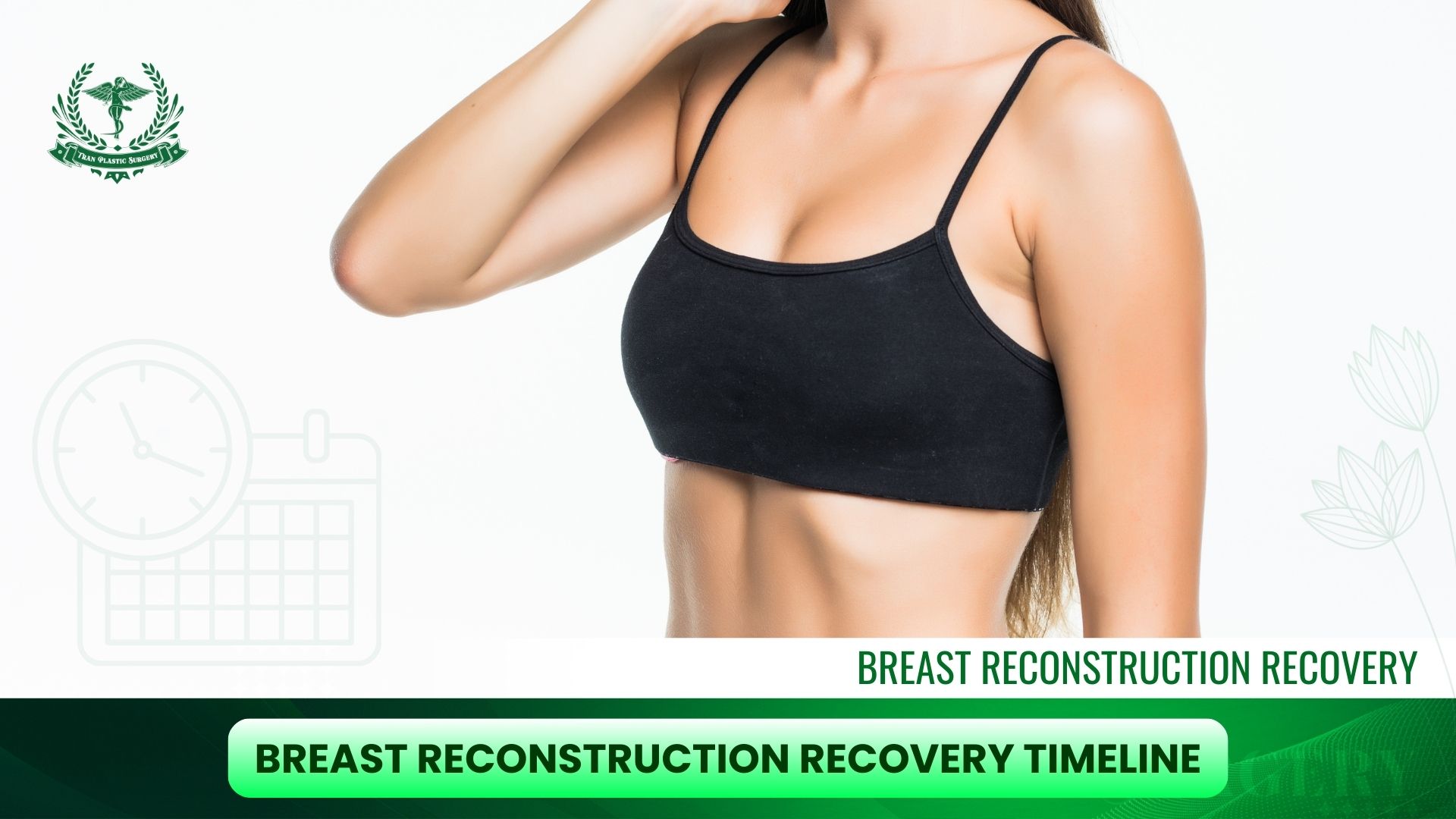
If you’re preparing for surgery, discuss your personal recovery timeline with Dr. Tuan Tran at Tran Plastic Surgery. Every woman heals differently, and having a clear plan tailored to your health and lifestyle is the best way to ensure a smooth breast reconstruction recovery. 👉 CONTACT NOW
Post-Op Care for a Smooth Breast Reconstruction Recovery
The days and weeks following surgery play a critical role in determining how well your body heals. Proper post-operative care not only prevents complications but also ensures the best possible cosmetic and emotional outcome. Below are essential strategies for a smoother breast reconstruction recovery.
1. Managing Pain and Comfort
- Follow your medication plan: Pain is expected after surgery, but it can usually be managed with prescribed pain relievers. Do not skip doses in the early days, as staying ahead of discomfort helps you move and rest more easily.
- Use support garments: A surgical bra or compression wrap provides stability, reduces swelling, and helps protect incisions.
- Position yourself wisely: Sleeping with your upper body slightly elevated using pillows or a wedge can reduce swelling and improve comfort.
2. Caring for Incisions and Drains
- Keep incisions clean and dry: Follow your surgeon’s instructions carefully. Avoid applying creams or ointments unless directed.
- Watch for warning signs: Redness, unusual discharge, or fever may indicate infection and should be reported immediately.
- Drain management: If drains are placed to remove excess fluid, measure output as instructed and keep the area clean to reduce infection risk.
3. Activity and Mobility After Surgery
- Gentle movement is key: Light walking in the first days after surgery improves circulation and lowers the risk of blood clots.
- Avoid heavy lifting: Most surgeons recommend avoiding lifting anything over 5–10 pounds for at least 4–6 weeks.
- Gradual return to activity: Gentle stretching or arm mobility exercises may be introduced after drains are removed, but always confirm with your care team before resuming exercise.
4. Nutrition and Rest
- Prioritize healing foods: A diet rich in lean protein, vitamins C and A, and zinc helps tissue repair and strengthens immunity.
- Stay hydrated: Adequate water intake supports circulation and reduces swelling.
- Rest strategically: Sleep is when your body repairs itself. Try to maintain 7–9 hours of restful sleep each night to support recovery
Recovery is just one part of the process. Learn everything you need to know about breast reconstruction, from procedure choices to long-term outcomes by reading our comprehensive guide: Breast Reconstruction Surgery: Options, Benefits & Recovery
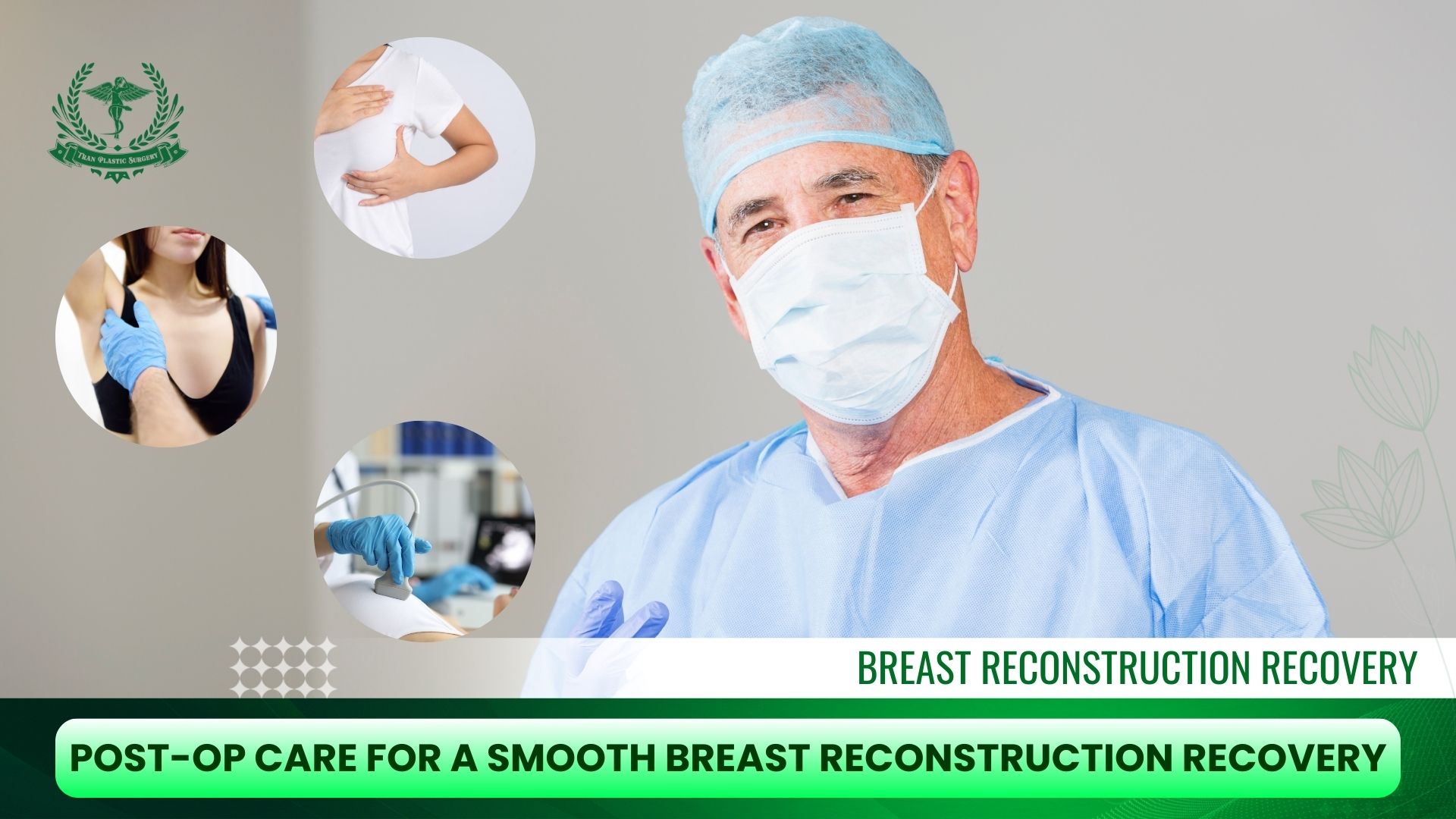
Emotional and Psychological Considerations in Breast Reconstruction Recovery
While most conversations about breast reconstruction recovery focus on physical healing, the emotional journey is equally important. Patients often experience a mix of relief, hope, anxiety, and even grief as they adjust to changes in their body. Recognizing these feelings as a natural part of recovery can help ease the process.
1. Common Emotional Experiences
- Body image adjustments: It can take time to accept scars, changes in breast shape, or differences in sensation.
- Anxiety about results: Many women worry if their breasts will look natural or symmetrical as healing progresses.
- Mood fluctuations: Hormonal changes, fatigue, and stress from surgery may cause irritability, sadness, or frustration.
2. Coping Strategies for Emotional Recovery
- Seek support early: Talking openly with your surgeon, nurse, or a counselor can provide reassurance.
- Connect with others: Support groups and patient communities help women realize they are not alone in their journey.
- Practice self-care: Activities like meditation, journaling, or light exercise can improve mood and boost overall well-being.
3. Long-Term Emotional Healing
Over time, most women report improved confidence and satisfaction with their decision to undergo reconstruction. Emotional recovery is not linear some days may feel harder than others but consistent support and self-compassion make the process smoother.
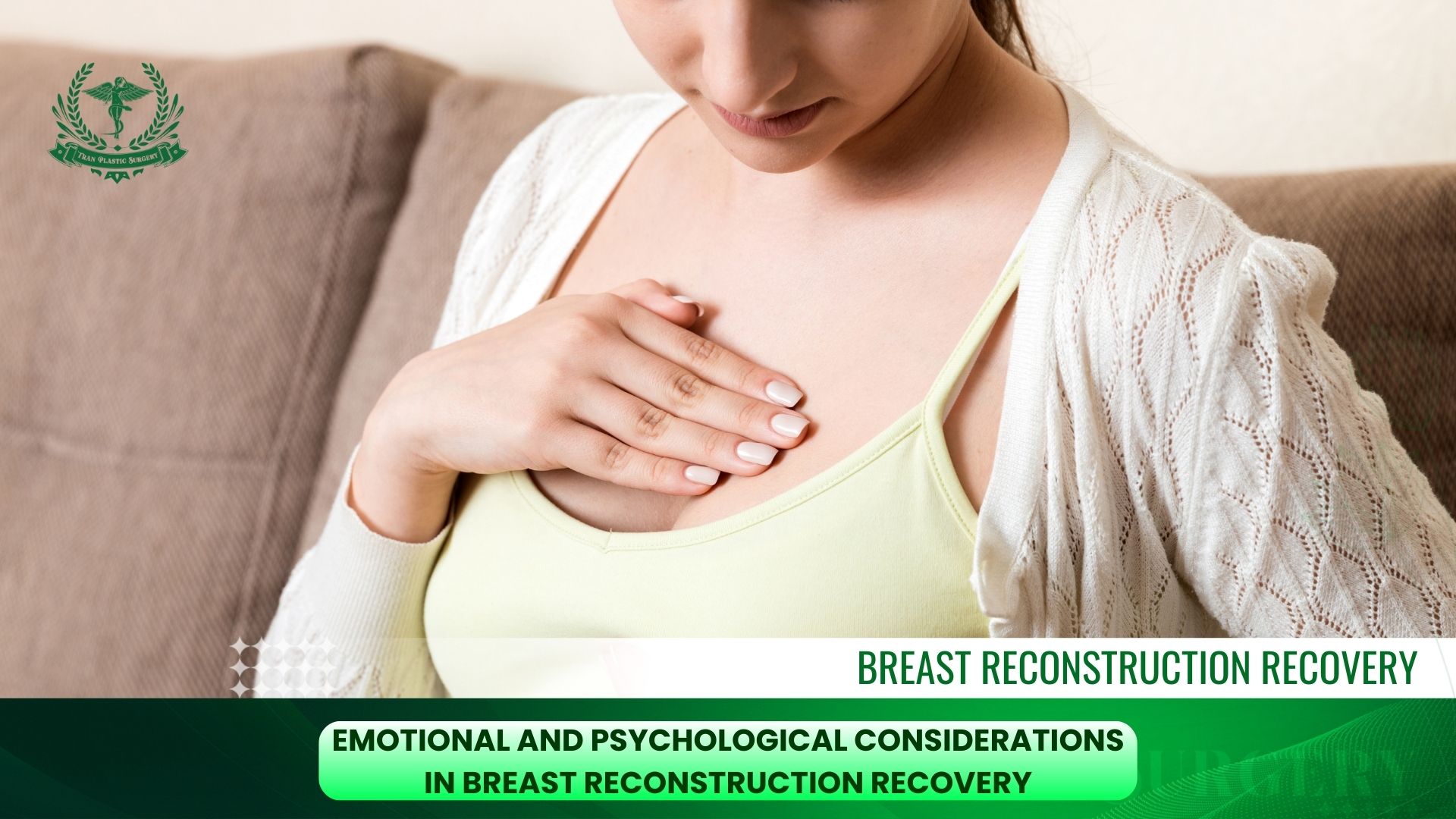
Common Challenges During Breast Reconstruction Recovery
Even with the best preparation, most women face some challenges during breast reconstruction recovery. Knowing what to expect and what requires medical attention helps patients feel more in control and less anxious.
1. Physical Challenges
- Swelling and bruising: These are common after surgery and may take several weeks to resolve.
- Numbness or tightness: Temporary loss of sensation in the chest or arm area is expected, especially if tissue was moved during surgery.
- Scarring: Incision lines will be noticeable at first but usually fade over time.
2. Medical Risks
- Infection: Redness, fever, or unusual discharge around the incision site may indicate infection and should be addressed immediately.
- Fluid buildup (seroma/hematoma): Some women experience fluid or blood collecting near the surgical site, which may require drainage.
- Implant complications: In rare cases, implants may shift, rupture, or cause discomfort, requiring revision surgery.
3. Emotional Challenges
- Frustration with slow progress: Recovery takes time, and it’s normal to feel discouraged when healing doesn’t happen as quickly as expected.
- Concerns about appearance: Adjusting to the reconstructed breast’s shape, texture, and sensation is a process that can take months.
- Fear of recurrence: Many women still worry about their cancer journey, adding emotional stress during recovery.
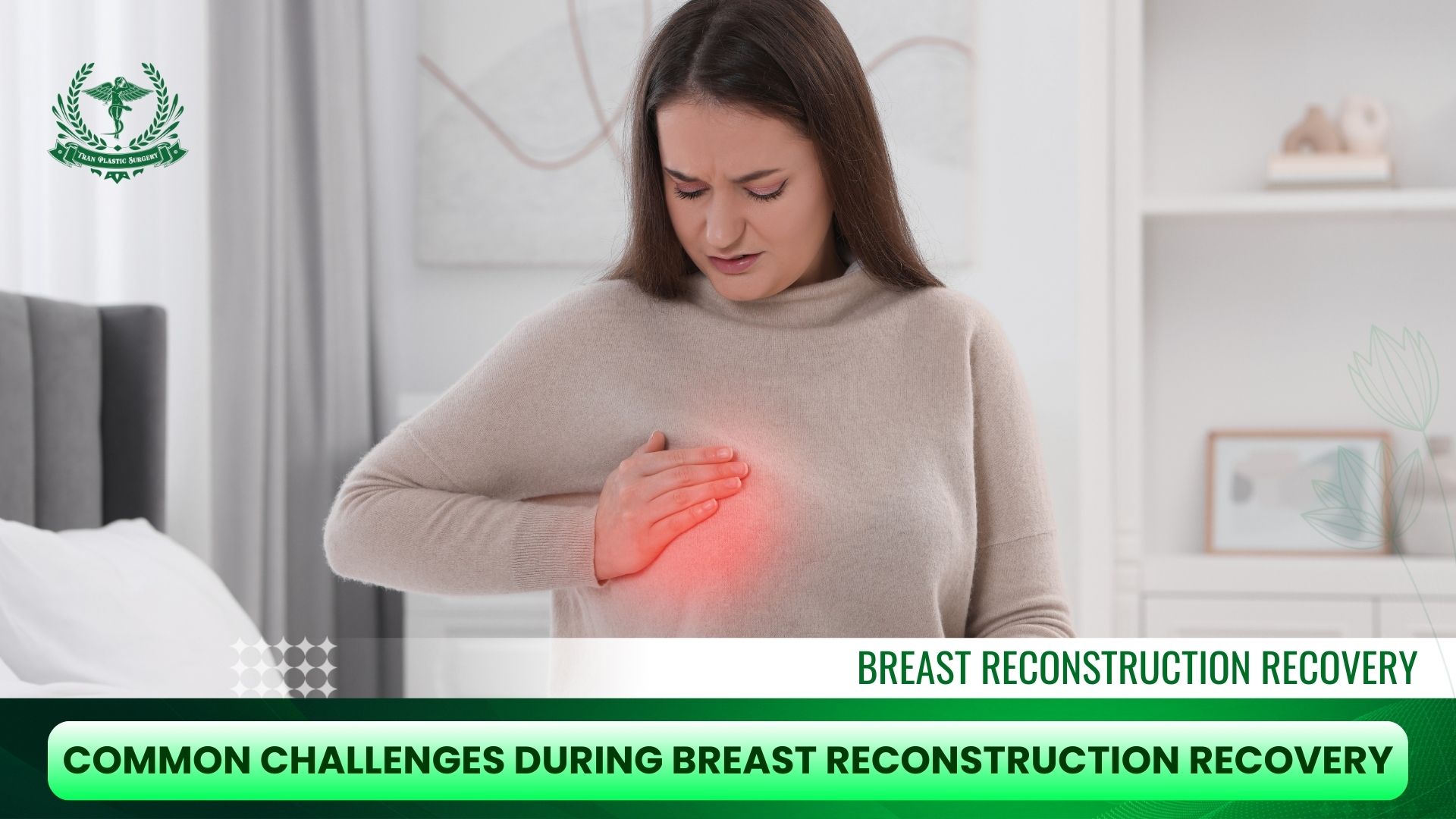
Facing these challenges doesn’t mean you have to go through recovery alone. The team at Tran Plastic Surgery is here to guide you through every stage of your breast reconstruction recovery from post-op concerns to long-term care. Contact Tran Plastic Surgery today to schedule a consultation and receive the personalized support you deserve.
When to Contact Your Surgeon During Breast Reconstruction Recovery
Even with excellent preparation and care, patients may still experience unexpected symptoms during their breast reconstruction recovery. While mild discomfort, swelling, or bruising are common and usually part of the healing process, there are certain warning signs that should never be ignored. Knowing when to contact your surgeon can make the difference between a minor issue and a serious complication.
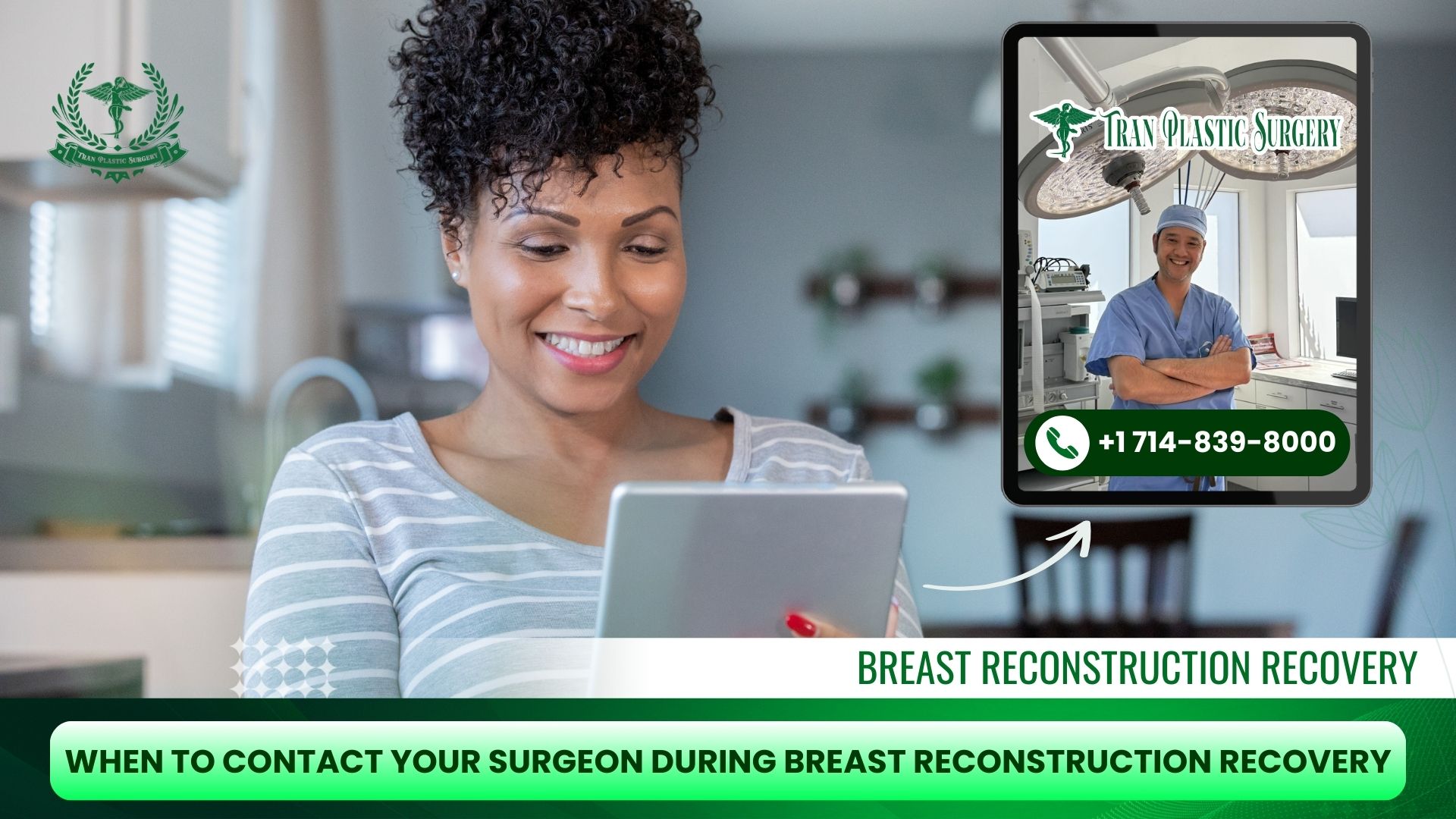
One of the first red flags is persistent or severe pain. Although some level of discomfort is normal after surgery, pain that suddenly worsens or does not improve with prescribed medication may point to an underlying problem. Similarly, signs of infection such as redness, warmth at the incision site, unusual drainage, or fever require immediate medical evaluation to prevent further complications.
Another potential issue during recovery is excessive swelling or fluid buildup. While mild swelling is expected, a sudden increase or hardness in the breast area may suggest a seroma (fluid accumulation) or hematoma (blood collection). Both conditions need prompt attention to avoid delaying healing. In addition, any noticeable changes in breast shape, skin color, or texture should be taken seriously. For example, skin that appears unusually dark or discolored could indicate compromised blood flow.
In very rare cases, symptoms such as shortness of breath, chest pain, or difficulty breathing may occur. These are medical emergencies and should be treated as such by seeking emergency care right away.
Equally important are your routine follow-up appointments. Even if recovery seems smooth, attending these visits allows your surgeon to monitor incision healing, manage drains, and confirm that the reconstruction is progressing as expected. Skipping check-ups may cause you to miss early signs of issues that are easier to treat when caught quickly.
Long-Term Care After Breast Reconstruction Recovery
Recovery does not end once the stitches heal. Long-term care is an essential part of breast reconstruction recovery, helping ensure the best results both physically and emotionally.
Scar Management
- Scars are a natural part of surgery, but over time they usually fade and soften.
- Your surgeon may recommend silicone sheets, scar creams, or massage techniques to improve appearance.
- Sun protection is important, as UV rays can darken scar tissue.
Lifestyle and Health Maintenance
- Healthy diet and exercise: Maintaining a balanced lifestyle supports tissue healing and overall well-being.
- Avoiding smoking and excessive alcohol: These habits slow down recovery and increase the risk of complications.
- Regular breast checks: Even with reconstruction, it’s important to attend routine screenings and follow-up exams as recommended.
Emotional Well-Being
- Adjusting to a new body image takes time. Many women report that confidence improves steadily over the first year after surgery.
- Support groups or counseling can provide ongoing reassurance as you navigate this stage of healing.
Long-Term Outcomes
- It may take 12–18 months for reconstructed breasts to fully settle into their final shape and feel.
- Some patients may choose additional procedures, such as nipple reconstruction or tattooing, for a more natural look.
Dr. Tuan Tran’s Expert Advice for a Smooth Breast Reconstruction Recovery
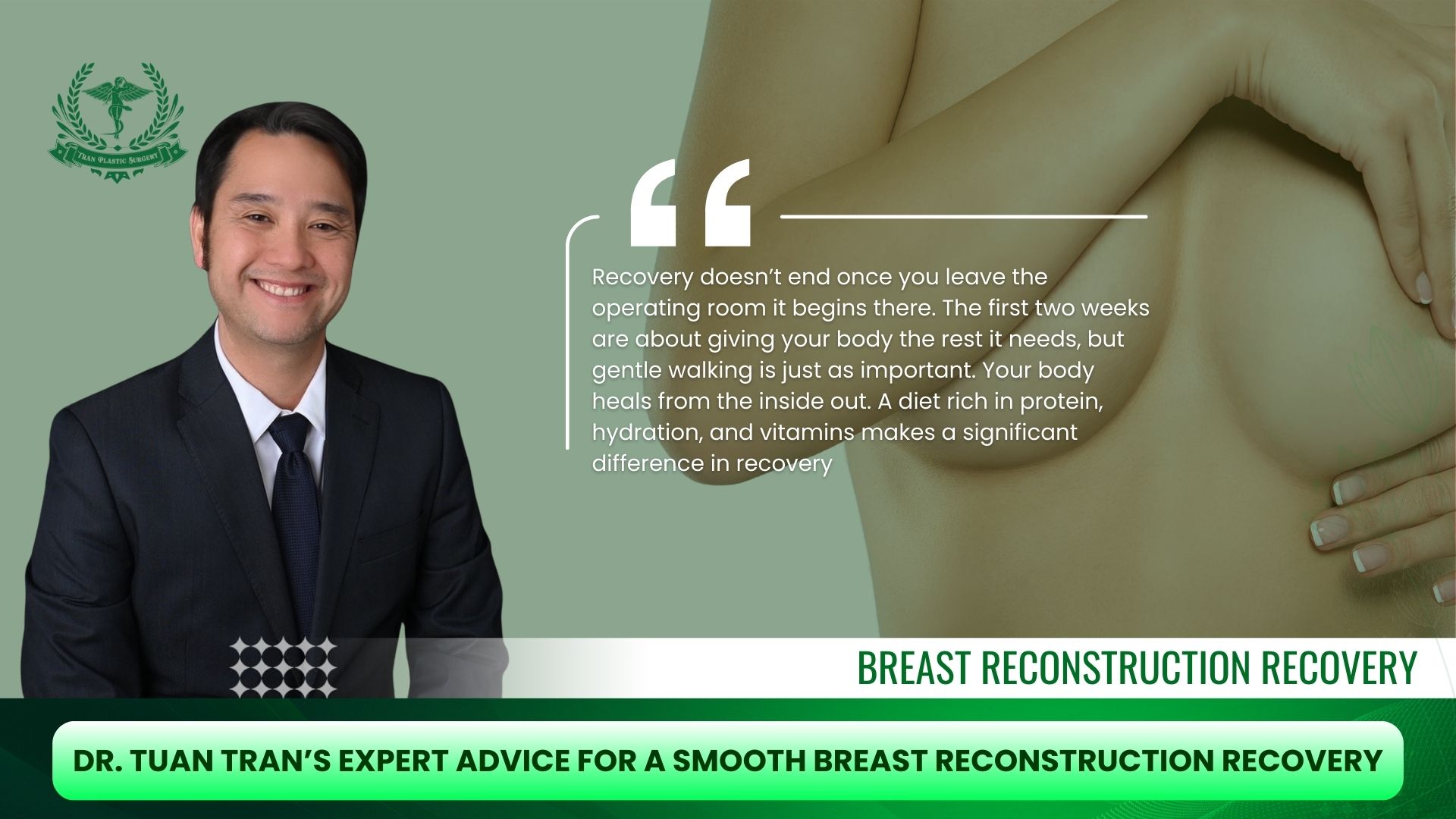
According to Dr. Tuan Tran, a smooth recovery after breast reconstruction surgery depends on patience, consistency, and clear communication with your surgical team. “Recovery doesn’t end once you leave the operating room it begins there,” he explains. For most patients, following post-operative instructions closely is the single most important step. Every detail, from taking prescribed medications to properly caring for surgical drains, is designed to reduce complications and support faster healing.
Dr. Tran also emphasizes the balance between rest and movement. “The first two weeks are about giving your body the rest it needs, but gentle walking is just as important,” he advises. Light activity helps improve circulation, lowers the risk of blood clots, and prevents stiffness, making it a key part of a successful breast reconstruction recovery.
Nutrition and self-care are also essential pillars of healing. “Your body heals from the inside out. A diet rich in protein, hydration, and vitamins makes a significant difference in recovery,” Dr. Tran says. Beyond physical healing, he encourages patients to recognize the emotional journey of recovery as well. Feelings about scars, body image, or anxiety over the results are normal and should never be ignored. Seeking support from family, peer groups, or professional counseling can make recovery feel more manageable and less isolating.
Finally, Dr. Tran reassures patients that no concern is too small to bring up. Whether it’s unexpected swelling, changes in breast shape, or unusual pain, reaching out early can prevent more serious complications. With the right care and guidance, he believes that patients can approach recovery with confidence and peace of mind.
FAQs About Breast Reconstruction Recovery
1. How long does breast reconstruction recovery take?
Recovery varies depending on the type of reconstruction, but most women can return to light activities in 4–6 weeks. Full breast reconstruction recovery, including scar healing and emotional adjustment, may take 6–12 months.
2. Is breast reconstruction recovery painful?
Some discomfort, swelling, and tightness are normal after surgery. Pain is usually manageable with prescribed medication and improves over the first 2–3 weeks. Support garments, rest, and gentle movement also help make breast reconstruction recovery more comfortable.
3. When can I return to work or exercise after breast reconstruction?
Most women return to desk jobs or light work within 4–6 weeks. Strenuous activity, heavy lifting, and high-impact exercise should be avoided for at least 6–8 weeks or until cleared by your surgeon. Recovery timelines can differ, so always follow your doctor’s guidance.
4. Will I regain normal sensation in my breasts?
Many patients experience numbness or tingling in the chest after surgery. Some sensation may return over time, but it’s common not to regain full feeling after reconstruction. This is a normal part of breast reconstruction recovery.
5. What are the warning signs I should contact my surgeon about?
Contact your surgeon immediately if you notice severe pain, sudden swelling, redness, fever, or unusual discharge from the incision site. These may signal complications that need prompt attention during your breast reconstruction recovery.





